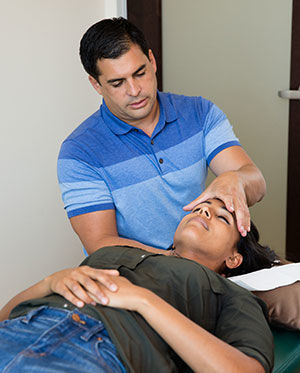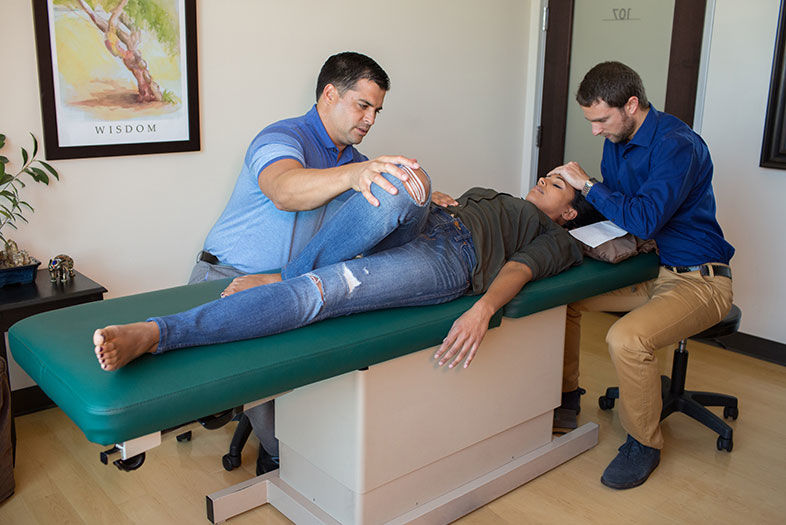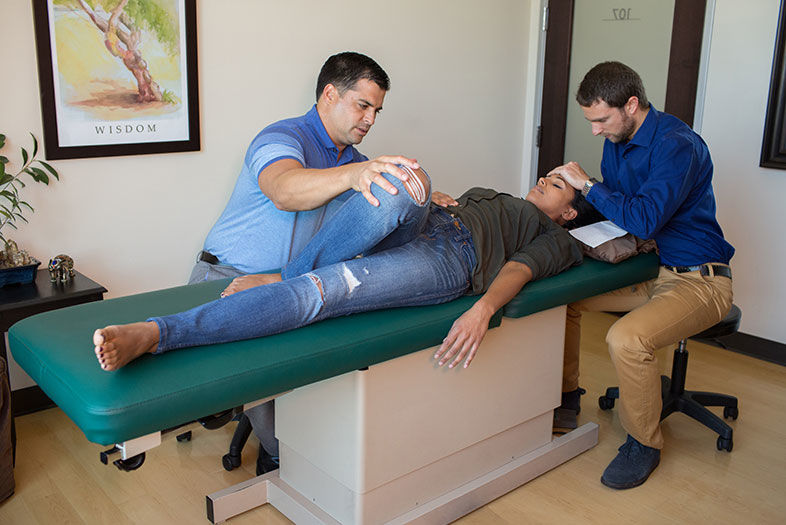All doctors of osteopathic medicine (DOs) have one foot in western medicine—they graduate from medical school—and one foot in holistic medicine. It’s no wonder many consider it the root of integrative care in the U.S. DOs also study osteopathic manipulative treatment (OMT), a hands-on procedure in which they manipulate parts of the body that in turn increase blood flow, decompress nerves, and improve movement within lymphatic areas. In other words, they aim to make the body function optimally so inherent self-healing mechanisms can do their job.
As someone who believes in the power of antibiotics as well as acupuncture, I was interested in OMT. And though I’m generally healthy, two problems have been plaguing me: upper back pain and a new bout of bruxism, the hard-to-beat habit of grinding or clenching one’s teeth.
I met with Dr. Michael Kurisu, a DO at UC San Diego who also practices OMT at Osteopathic Medical Associates San Diego, a gleaming facility in Serra Mesa that feels nothing like a sterile doctor’s office. He began with an osteopathic structural exam. As I stood tall, Kurisu felt joints and muscles to see how my body was “carrying itself.” He could (correctly) feel that I had pulled a muscle in my left lower back last year. He also (correctly) sensed that my whole right side was generally tighter than my left. The process made me realize how little doctors touch their patients anymore.
Next, I sat on the table, where Kurisu asked me to extend my arm. From this he could gauge that the angle from my elbow through my forearm and hand, called a carrying angle, was slightly wider than usual. It wasn’t a problem, just a consideration for activities like downward-facing dog in yoga. (Because of my angle, I should think about keeping my arms slightly broader than shoulder-width distance.)
Once I lay on the padded table, Kurisu and third-year medical student Ryan Bart began pushing almost imperceptibly on my feet, abdomen, and other areas. It felt like a gentle massage, until he began focusing on specific issues.
The process made me realize how little doctors touch their patients anymore.
He asked me to take deep breaths, arms crossed, while he twisted my spine, and after a few breaths, he pressed down and—pop!—cracked my back. The relief was instant and amazing. Kurisu explained that my fourth rib had been “stuck in inhalation,” and when I took a deep breath, the fourth rib wasn’t exhaling properly, causing a bend in my back. (If this sounds similar to going to a chiropractor, it should; chiropractic techniques stem from osteopathy.)
Kurisu then began performing osteopathic cranial techniques, a gentle method of aligning cranial and sacral bones that’s claimed to be particularly helpful for people with neurological issues, like Parkinson’s. While cradling my head, he noticed that one of my neck vertebrae was off-kilter. So after rocking my head gently, he whipped it to one side, creating an audible crack. For someone who’s never been to a chiropractor but has a habit of cracking her knuckles, toes, and back, it caught me off guard, but was a welcome move. Kurisu explained that he doesn’t pop just anyone’s joints. It’s not necessarily appropriate for an 80-year-old arthritic patient, he said, but he could sense from my relaxed state that I could handle it.
He put on exam gloves and lightly pushed around my mouth. From touch alone, he could feel that my bite was off and temporal bones were internally rotating, which was causing a strain in my jaw and neck. He couldn’t tell me why I was clenching my teeth. That answer lay in my subconscious, and to tap into that, he suggested I analyze my dreams and sketch at random. For instance, if I draw a tree, what kind of tree first comes to mind? A breezy palm or a desiccated shrub or something in between? It’s not the answer some would like to hear, but for someone like me who believes in the power of yoga, meditation, and the subconscious—I was soaking it all up.

I Tried It: Osteopathic Manipulative Treatment
Jennifer Siegwart Rebecca Batista
While Kurisu was feeling around my head, Bart noticed that my left leg was longer than my right, but that was because my pelvis was anteriorly rotated. He performed a muscle energy technique—which involved pushing on my bent right leg—to realign.
After treatment, I felt like I had just come out of yoga. Kurisu explained that my brain was producing theta waves, the same kind that appear during meditation and the first stages of sleep. “I tell people not to make any major decisions after treatments,” he joked. He also warned me that I might be sore for the next day or two.
And he was right. The following morning the neck pain had vanished, but I felt tight all over, like I needed to keep popping joints—a normal outcome, he said—to release tension (the goal is to have less tension, therefore less desire to pop). On day two I felt much more balanced and flexible, with a newfound body awareness. I flexed deeper into yoga poses than ever before and could almost visualize my muscles working during class. I also automatically got up from my desk chair more frequently—as if I had an internal alarm clock to nix sitting too long. A week later, I’m still reaping the more balanced benefits.
Osteopathic treatments are supposed to last longer than chiropractic manipulation, but they don’t come cheap. At this center, 1.5-hour new patient visits start at $290. Some PPO insurance plans will offer partial reimbursement. But the idea is that you don’t need to go as often as a chiropractor, and also that treatments help make you more in tune with your body, which ideally leads to better lifestyle choices.
For example, to combat my upper back pain, I’ve taken Kurisu’s advice to get a sit-stand desk so I’m standing for 80 percent of my work day. I’m also going to stretch more and continue yoga with a side of meditation. Dream interpretation? That’s next. All together, it’s my perfect version of medicine for an integrated mind, body, and soul.

I Tried It: Osteopathic Manipulative Treatment
Jennifer Siegwart Rebecca Batista


















